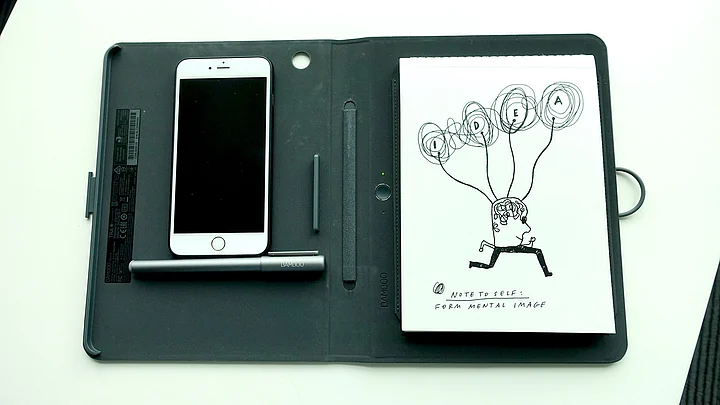A trusty pen and pad is still the companion of choice for many folks, even though we’re surrounded by smartphones and tablets everywhere we go.
That being said, notebooks aren’t text-searchable (and we’re quite often searching for them too!). Sharing paper notes isn’t easy, and let’s be honest, most of us can’t read our own handwriting six months down the line.
Wacom, known for its graphics tablets and styluses, is looking to solve this problem with the Bamboo Spark. The Bamboo Spark is what you would call a ‘smart folio’, a folder that ostensibly looks like a regular pen-and-paper combo but syncs your notes and doodles to your phone or tablet.
Pros:
- Easy setup and use
- Quick syncing
- Great for digitising hand-written notes
- Can be used with any A5 note-pad
Cons:
- Lacks accurate pressure sensitivity
- Too small for extensive note-taking
- No voice recording
- No option to change pens
What’s Good?
The Bamboo Spark comes in versions that will suit your requirements, as long as you’re not discouraged by the sticker shock, the folio being priced at Rs. 10,975.
You can either pick up a version with a pocket for your smartphone or extra paper, or for tablets with screen size up to 9.7 inches. Whichever version you pick, the folio itself is well-built and wouldn’t look out of place in a workplace.
There’s only a small on/off button on the bottom and a button on the inner spine used for syncing to devices to let you know that this is no ordinary notepad. The pen feels and writes just like any other slightly thick-ish ballpoint, and it really drives home how natural and intuitive the system is.
Setup is easy — just download the accompanying Bamboo Spark app and follow the on-screen instructions to get started on drawing and syncing within a few minutes of opening the box.
The Bamboo Spark works by detecting pen movement and pressure on the page and stores it in memory. You write a pageful on the A5-sized pad, hit the button and the image is transferred to app. It works with practically any A5 pad, as long as it’s not too thick, and doesn’t require special paper to track your notes, unlike some of the competition.
A handy LED keeps you informed when it is ready to record and when it is sensing pen movement on the page.
Once your notes are on the app, you can export your notes as searchable text using cloud-based handwriting recognition, or as a JPG image or a Wacom Ink Layer Language (WILL) file for exporting to other apps that support the digital inking format.
Handwriting recognition is in beta but worked fairly well. Within the app, you can even replay each line in your drawing, undoing each pen stroke and exporting the page in that particular state, which is rather neat.
What’s Bad?
While the system works perfectly well for note-taking, drawing is a bit of a hit-and-miss. The Bamboo Spark’s sensor is supposed to be able to sense pressure, but realistically only works with hard or a medium pressure, with light lines and shading sometimes failing to register.
Although this is not a deal-breaker for note taking or casual doodling, if you’re planning to use this for making artwork or detailed sketches, you’re better off with a proper Wacom graphics tablet.
Since the pen-and-pad are a tightly-mated system, you can’t swap the Wacom pen for your favourite pen. Also, the A5-sized pad can be a bit limiting for extensive note taking or bigger drawings.
There is no audio recording capability either. You’ll also want to be careful not to move the page while drawing/writing, which can result in a distorted end product.
Why Buy It?
The Bamboo Spark is well-built, easy-to-use product that does exactly what it claims, which it does reliably. Sure, the pressure sensitivity could have been several notches better, and if the pad was at least an A4 size, it would be a lot more useful.
Even so, one couldn’t imagine something at this price point replacing laptops for quick-and-dirty note taking in classrooms.
It sounds like the sort of device that’s perfect for someone who loves taking their hand-written notes, and if that someone is you, it’s certainly worth investing in this innovative little note-taking companion.
( Tushar Kanwar is a technology columnist and commentator and has been contributing for the past 15 years to India’s leading newspapers and magazines. He can be reached on Twitter: @2shar)
